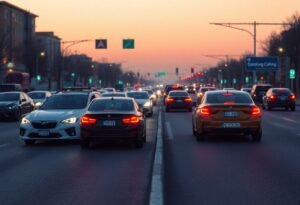The advent of autonomous vehicles is reshaping urban planning, presenting unique opportunities and challenges for innovation in transportation, infrastructure, and city living.
The Integration of Autonomous Vehicles into Urban Landscapes
The integration of autonomous vehicles into urban landscapes marks a significant revolution in how cities operate. As urban populations continue to swell, cities must embrace innovation to manage increased demand for transportation. The presence of driverless cars can lead to a decrease in traffic congestion, as they utilize algorithms to optimize routes. Moreover, these vehicles can operate more efficiently within shared transportation networks, potentially reducing the number of cars on the road. This shift may pave the way for diverse innovations in urban design, emphasizing space reallocation for pedestrian-friendly zones and green areas.
Reimagining Road Infrastructure
The rise of autonomous vehicles necessitates a reevaluation of existing road infrastructure. Traditional road designs, predominantly tailored for human-driven cars, may become inadequate in accommodating self-driving technology. Innovative urban planners must consider the implications of vehicle interconnectivity and communication systems to create a more effective traffic management framework. Moreover, roads might be designed to prioritize safety and efficiency, with dedicated lanes for autonomous vehicles, leading to reduced accidents and improved traffic flow.
Impact on Public Transportation Systems
Autonomous vehicles are poised to transform public transportation systems. By offering on-demand services, driverless cars can supplement existing transit routes, especially in areas where traditional public transport is less viable. This innovation in transport could lead to fewer under-utilized bus routes and greater accessibility for residents. As cities leverage these technologies, they can enhance existing infrastructure while also ensuring services are adaptable to the needs of all citizens, contributing to a more inclusive urban environment.
Zoning Regulations and Land Use Changes
The advent of driverless cars will necessitate changes in zoning regulations and land use dynamics. With less emphasis on parking areas, cities will have the opportunity to repurpose land for other uses, such as parks, residential buildings, and commercial spaces. This reallocation can not only improve the quality of urban life but also promote sustainability. Planners must engage with community stakeholders to identify preferred uses, ensuring that changes reflect public needs and aspirations.
Sustainable Urban Development
The impact of autonomous vehicles on urban planning extends into the realm of sustainability. These vehicles can be integrated with renewable energy solutions, such as electric charging stations powered by solar energy. Additionally, with reduced reliance on personal vehicles, cities can aim for lower carbon emissions, contributing to international sustainability goals. By promoting green spaces and enhancing public transit options, cities can harness the full potential of autonomous vehicles while fostering a cleaner urban environment.
Innovative Business Models and Economic Impact
The introduction of autonomous vehicles is also likely to foster new business models and economic opportunities. Companies can explore ride-sharing platforms, logistics, and delivery services that utilize driverless technology. Such innovations can create jobs and stimulate local economies. By embracing the shift towards autonomous transport, urban planners will have to adapt their strategies to promote growth while ensuring that the economic benefits are equitably distributed among diverse communities.
Disclaimer: This article is for informational purposes only and does not profess to cover all aspects of the impact of autonomous vehicles on urban planning. Readers are encouraged to conduct further research.





















